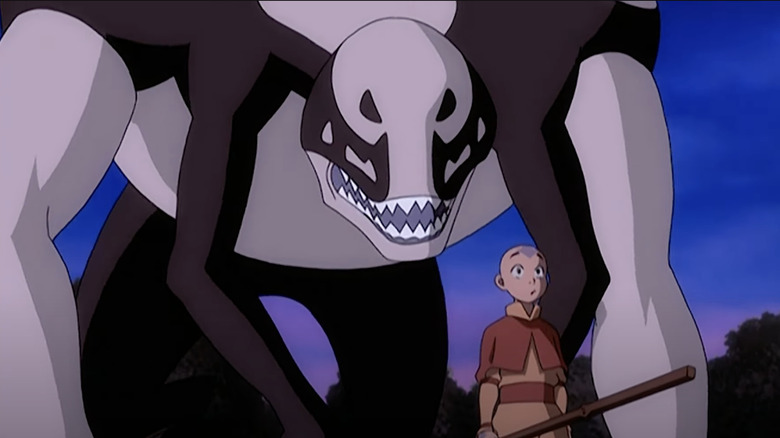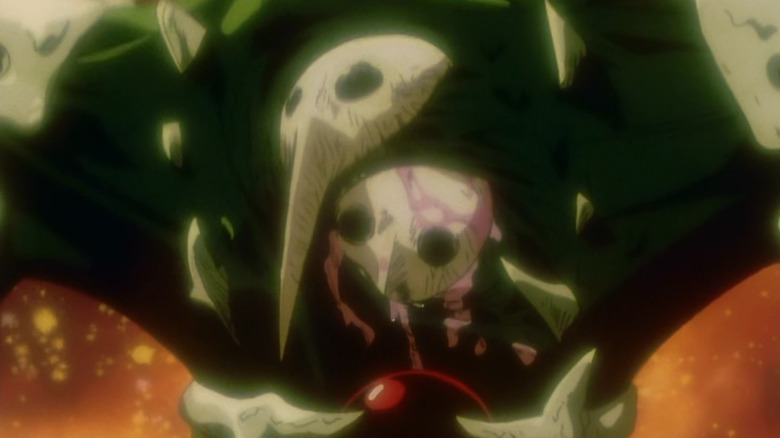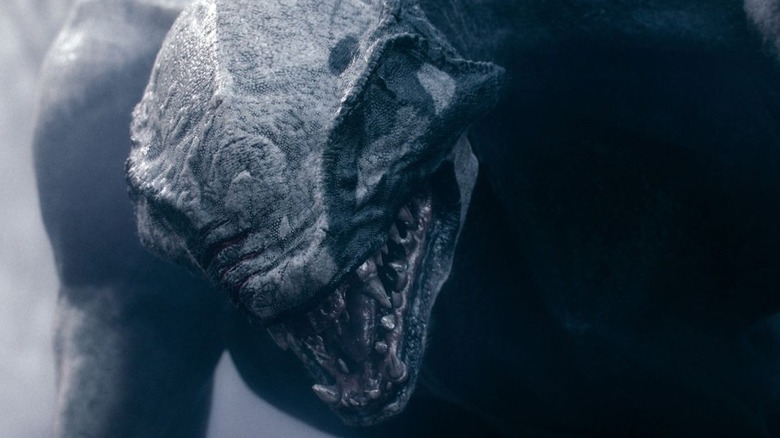This Avatar: The Last Airbender Spirit Was Inspired By A Classic Anime Monster
In the animated "Avatar: The Last Airbender," the Avatar is meant to be a bridge between the human and the spirit worlds, a neutral party who can keep the two realms in equilibrium. Avatar Aang first ventures into the spirit world in the seventh episode of season 1: "The Spirit World (The Winter Solstice, Part 1)."
In this episode, Aang and co. visit Senlin Village, a small forested town in the Earth Kingdom. A Fire Nation attack left the neighboring forest burnt down. The village's troubles don't end there, for they're being attacked at night by a monstrous spirit, Hei Bai. Aang learns that Hei Bai is the guardian of the forest and has been angered by its destruction (a la "Princess Mononoke"). He helps the black-and-white spirit understand what happened, and Hei Bai returns to his docile natural form: a giant panda.
This episode was loosely adapted in Netflix's new live-action remake of "Avatar: The Last Airbender," specifically episodes 5 ("Spirited Away") and 6 ("Masks"). Hei Bai looks much like it did in the cartoon (albeit with a murkier color scheme); a bear-like four-legged body, an eyeless snake-like snout (but with the teeth of a shark), and a pair of dexterous arms extending from the same root as its front legs.
As confirmed in the behind-the-scenes book "Avatar: The Last Airbender – The Art of the Animated Series" (published by Dark Horse Comics, written by series co-creators Bryan Konietzko and Michael Dante DiMartino), Hei Bai's design in the cartoon (and thus the live-action series) comes from a famous anime: "Neon Genesis Evangelion."
The Angels of Neon Genesis Evangelion
"Evangelion," made by Japanese animation studio Gainax, aired 26 episodes from 1995 to 1996 (and then several follow-up movies). The series follows young children who pilot monstrous cyborgs called Evangelions (or Evas for short) to fight enormous and destructive beings called Angels. The Angels are way more horrifying and ethereal than your garden-variety Kaiju and the show, as you might have guessed, dresses up its internal mythology with Abrahamic theological ideas. (Funnily enough, "Avatar: The Last Airbender" is a mirror of this; it's a Western cartoon that took its underpinnings from Southeast Asian culture.)
Rather than an omnipotent God who carefully crafted the universe in seven days, the Angels and humanity were created by a "First Ancestral Race" and are the result of carelessness. The "Fruit of Life" (named Adam) and the "Fruit of Knowledge" (Lilith) both ended up on primordial Earth and now their descendants vie for dominance. Adams' descendants, the Angels, have great strength but are ruled by instinct. Humanity, the "Lilin," are small and fragile but intelligent.
Little of this backstory is spelled out in the show, and honestly, the literal lore of "Evangelion" is the least interesting thing about it. Director Hideaki Anno's filmmaking verve and the series' themes of human connection, particularly how it's possible to be surrounded by people and still feel lonely, are why it has endured.
Even so, the Angels all have inspired designs. Their uniformly massive and "biomechanical" look inspired the alien in Jordan Peele's "Nope," which has the silhouette of a flying saucer but is really a hovering organic mass. The variety in the Angels' appearances makes parsing the exact influence on "Avatar: The Last Airbender" tricky.
Angelic influence in Avatar: The Last Airbender
The Angels in "Evangelion" are named after Biblical angels and they look as incomprehensible as the Bible describes. Some of the weirdest examples include Ramiel, Angel of Thunder (a floating blue octahedron), Ireul, Angel of Terror (a computer virus), and Armisael, Angel of the Womb (a glowing ring of light with a double-helix pattern, evoking an angelic halo).
"Avatar: The Last Airbender – The Art of the Animated Series" merely says that Hei Bai's design was inspired by "The Angels" collectively, without naming a specific one. However, I think it's safe to say that those three aforementioned weirdos weren't on Konietzko and DiMartino's minds when drawing Hei Bai. Instead, I'd wager the primary influence is the first Angel seen in the series: Sachiel, the Angel of Water (in "Evangelion" episode 1, "Angel Attack," Sachiel is seen swimming and emerging from the water like Godzilla). Though Sachiel introduces the audience to the Angels, it's referred to by the characters as the Third Angel (after Adam and Lilith).
Sachiel is one of the more humanoid angels and has a skeletal motif (it has a skull-like head and external rib cage). Its black-and-white color scheme resembles Hei Bai, as do its prominent shoulders. The skull-like marking on Hei Bai's head likewise has the same features as Sachiel's mask. A few later Angels pull design cues from Sachiel (Israfel, the Twin Angels of Poetry, Music, and Dance, and Zeruel, the Angel of Strength, have similar skull-like mask faces). For the most part, though, they keep getting less and less human-like.
My journey to loving anime included both "Avatar: The Last Airbender" and "Neon Genesis Evangelion," so it thrills me that the two shows include overlapping creative DNA.
"Avatar: The Last Airbender" is streaming on Netflix.


